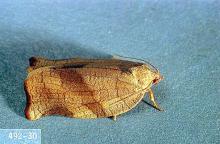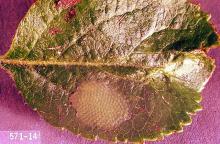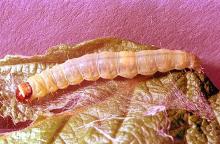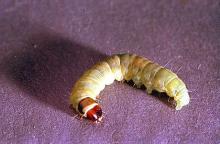Choristoneura rosaceana
Pest description and crop damage Bright green caterpillar with a black or brown head. Most feeding is on leaves and the larvae roll leaves together using silk to create protected feeding sites. The larvae can also inhabit the area between the husk and the shell of the nut, and when they do, damage to nuts can occur from feeding on green shells. Occasionally, the larvae may penetrate shells and feed on kernels. Leafroller damage to nuts is distinguished from filbertworm damage by additional scarring and deformation on the shell surface rather than a clean exit hole from the shell. Adult moths are bell-shaped, up to 1 inch long, tan to brown, with broad bands on the wings. Their appearance is very similar to the filbert leafroller, although the filbert leafroller has a more pronounced bell shape to the wings when viewed from above.
Biology and life history There are two generations of obliquebanded leafroller each season, occurring from May through harvest. Early stage (minute) larvae overwinter under the bark on scaffold branches of a variety of host plants and may feed during warm periods in winter but become active in spring with the onset of new growth and they move into the buds. Larvae exhibit a characteristic rapid backwards wiggle from the feeding site when disturbed. They feed for several weeks in the leaves, typically forming a new feeding site prior to pupation. Adult moths emerge in late June to July. These moths lay eggs for the second generation. The second generation hatches in early July. Larvae feed on leaves but may occasionally damage nuts if their feeding site happens to be within a nut cluster or in direct contact with a nut cluster.
Pest monitoring Start checking for larvae around mid-March by inspecting three terminals per tree and three leaf clusters per terminal. Each terminal is a sampling unit. If the orchard has a history of leafroller problems, it is important to sample the larvae early. Check for adults by using one pheromone trap for every 5 acres, placed 6 ft high in the tree canopy starting in mid-May. Treat larvae when the infestation level is 20 to 25%. Treat for adults when the catch is 40 moths per week and larvae are feeding on nuts. The first flight usually is in June. Spray when pheromone traps catch five to eight moths over a 3-day period. The second flight usually is in September.
Management-biological control
Obliquebanded leafroller larvae are targeted by a wide variety of specialist and generalist parasitoids that normally keep populations under control after the spring generation. Sprays are rarely necessary, and if they are applied against mature larvae, they will likely harm natural enemy populations. By the time larvae reach maturity, their damage has been done and biological control is intense. Examine feeding sites of mature larvae to get an idea of natural enemy activity. Small cocoons or caterpillars being consumed by small larvae indicate active biocontrol. Conserve natural enemies through judicious insecticide use but monitor leafroller numbers as population build-up can be rapid.
Management-chemical control: HOME USE
If necessary, spray in spring after overwintering larvae emerge, around the time leaves are 0.75 to 1 inch long. Control is much more effective if sprays are applied when larvae are small, but these young larvae are the most difficult to detect.
- azadirachtin (neem oil)-Some formulations are OMRI-listed for organic use.
- Bacillus thuringiensis var. kurstaki-Some formulations are OMRI-listed for organic use.
- carbaryl (Gardentech Sevin Conc. Bug Killer)-May cause rapid increase of aphid populations 3 to 4 weeks after application. Extremely toxic to aquatic invertebrates.
- esfenvalerate (Monterey bug buster II)-Extremely toxic to fish and aquatic habitat.
- kaolin (Surround at Home)-Use 0.25 to 0.5 lb per 1 gal water.
- potassium laurate (as mix with Spinosad)
- pyrethrins (often as a mix with other ingredients)-Some formulations are OMRI-listed for organic use.
- spinosad- Some formulations are OMRI-listed for organic use.
- zeta-cypermethrin
Management-chemical control: COMMERCIAL USE
- alpha-cypermethrin (Fastac CS) at 3.2 to 3.8 fl oz/A (0.021 to 0.025 lb ia/A). PHI 7 days. REI 12 hr. Do not exceed 11.4 fl oz/A per season. Highly toxic to bees, and extremely toxic to fish and aquatic invertebrates. Do not apply within 25 feet of aquatic habitats, or with 150 ft if aerial application. Apply as indicated by scouting.
- Bacillus thuringiensis var. kurstaki-See label for rates. PHI 0 days. Apply with a spreader-sticker. Some formulations are OMRI-listed for organic use.
- bifenthrin-
- Brigade WSB at 0.05 to 0.2 lb ai/A. PHI 7 days. REI 12 hr. Do not graze livestock on treated cover crops. Highly toxic to bees and toxic to fish and aquatic invertebrates.
- Fanfare EC at 3.2 to 12.8 fl oz/A (0.05 to 0.20 lb ai/A). PHI 7 days. Do not graze livestock on treated cover crops. Highly toxic to bees and toxic to fish and aquatic invertebrates.
- carbaryl (Sevin XLR Plus) at 0.5 to 1.25 quarts/100 gal water (2 to 5 quarts/A). PHI 14 days. REI 12 hr. May cause a rapid increase of aphid populations 3 to 4 weeks after application. Extremely toxic to aquatic invertebrates.
- chlorantraniliprole-
- Altacor at 3 to 4.5 oz/A (0.066 to 0.099 lb ai/A). PHI 10 days. REI 4 hr.
- Vantacor at 1.7 to 2.5 oz/A. Make no more than 4 applications per year and do not reapply within 7 days. PHI 10 days. REI 4 hr.
- cyfluthrin (Baythroid XL) at 2 to 2.4 oz/A (0.016 to 0.019 lb ai/A). PHI 14 days. REI 12 hr.
- diflubenzuron (Dimilin 2L) at 12 to 16 fl oz/A. PHI 28 days. REI 12 hr. Extremely toxic to aquatic invertebrates. Do not apply within 25 ft of bodies of water.
- diazinon (Diazinon AG 500) at 1 pint/250 to 400 gal water/A. No more than one application per season. PHI 45 days. REI 18 days. Washington and Oregon only.
- emamectin benzoate (Proclaim) at 3.2 to 4.8 oz/A. PHI 14 days.
- esfenvalerate (Asana XL) at 7.3 to 12.8 fl oz/100 gal water (9.6 to 19.2 fl oz/A or 0.05 to 0.1 lb ai/A). PHI 21 days. REI 12 hr. Do not exceed 0.2 lb ai/A per season. Extremely toxic to fish and aquatic habitat.
- fenpropathrin (Danitol 2.4 EC) at 10.3 to 21.3 oz/A (0.2 to 0.4 lb ai/A). PHI 3 days. REI 24 hr. At least 50 gal (100 gal better) water for ground applications. Note buffer requirements for use near aquatic zones.
- GS-omega/kappa-Hxtx-Hv1a (Spear-Lep) at 1 to 2 pints/A. Biological insecticide that should be tank mixed with equal parts of Bt. PHI 0 day. REI 4 hr.
- lambda-cyhalothrin-
- Warrior II at 1.28 to 2.56 fl oz/A (0.02 to 0.04 lb ai/A). PHI 14 days. REI 24 hr. Do not exceed 0.16 lb ai/A per season or 0.12 lb ai post bloom.
- LambdaStar at 2.56 to 5.12 fl oz/A. PHI 14 days. REI 24 hr. Do not exceed 0.16 lb ai/A per season or 0.12 lb ai post bloom.
- Grizzly Too at 1.28 to 2.56 fl oz/A. PHI 14 days. REI 24 hr. Do not exceed 0.16 lb ai/A per season or 0.12 lb ai post bloom.
- methoxyfenozide (Intrepid 2F, generics) at 0.12 to 0.25 lb ai/A. PHI 14 days. REI 4 hr. Do not apply within 25 ft of an aquatic habitat, 150 ft if applied by air.
- Spring (overwintering) generation-Apply once or twice, depending on infestation level.
- Summer generation-Apply first during the period of peak egg lay to early egg hatch (200 to 400 DD, following biofix). Reapply 10 to 18 days later (usually 500 to 700 DD). Do not exceed 24 fl oz/A per application or 64 fl oz/A (1 lb ai/A) per season. Do not apply within 25 ft of an aquatic habitat, 150 ft if applied by air.
- methoxyfenozide + spinetoram (Intrepid Edge) at 6 to 12 oz/A. Apply at initiation of egg hatch, if necessary reapply after 14-21 days, but not before 14 days. PHI 7 days. REI 4 hr. No more than 12 fl oz/A/season.
- permethrin-
- Ambush 25W 12.8 to 25.6 oz/A. PHI 14 days. REI 12 hr. Do not graze treated orchards. Extremely toxic to fish and aquatic habitat.
- Pounce 3.2 EC at 0.5 to 1 pint/A. PHI 14 days. REI 12 hr. Do not graze treated orchards. Extremely toxic to fish and aquatic habitat.
- PermaStar AG at 8 to 16 oz/A. PHI 14 days. REI 12 hr. Highly toxic to bees, toxic to fish and aquatic invertebrates.
- pyriproxyfen (Esteem 35 WP) at 3.2 to 4 oz/100 gal water (13 to 16 oz/A). Do not apply more than twice per season. PHI 21 day. REI 12 hr.
- spinosyns-
- spinetoram (Delegate WG) at 1.5 to 1.75 oz/100 gal water (4.5 to 7 oz/A). PHI 14 days. Apply no less than one week apart, with a maximum 4 applications per season.
- spinosad (Entrust SC) at 4 to 10 oz/A (0.06 to 0.16 lb ai/A). PHI 1 days. REI 4 hr. OMRI-listed for organic use.
- spinosad (Success Naturalyte) at 4 to 10 oz/A in 100 gal water (0.06 to 0.16 lb ai/A). PHI 1 days. REI 4 hr. Do not exceed 29 oz/A per season.





